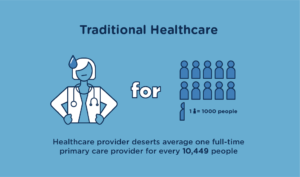Blog Posts
Addressing Healthcare Deserts with Affordable Solutions
A 2021 report by GoodRx found over 80 percent of counties in the U.S. lack some form of healthcare infrastructure. These counties where people have limited access to healthcare services have been labeled “healthcare deserts.” Roughly 121 million people, or 37 percent of the population, currently live in a healthcare-desert county, according to the report.
The report examines the lack of access to healthcare facilities and providers in six key areas. They include primary care providers, pharmacies, hospitals, hospital beds, trauma centers, and low-cost health centers. The numbers concerning access to primary care are particularly concerning as primary care providers are often considered the gatekeepers to good health and wellbeing. Here we’ll examine the problem and highlight solutions that can address the needs of healthcare deserts nationwide.
A One to 10,449 Ratio
GoodRx says more than 9 percent of U.S. counties are primary care provider deserts. An estimated 13 million Americans live in areas where demand for primary care far outpaces the supply. According to the report, healthcare provider deserts average one full-time primary care provider for every 10,449 people. That’s an impossible caseload for any provider.

It’s also not surprising that limited access to healthcare is more likely to affect people who already face disparities. Americans with low income, no insurance, and technology barriers such a limited internet access suffer the most. Areas that lack federally funded low-cost health centers comprise 45 percent of U.S. counties. The report estimates 78 million people don’t have a low-cost health center nearby and would need to drive more than 20 minutes to reach the nearest clinic.
Household Income and Healthcare Deserts
The relationship between the average household income and healthcare infrastructure in an area is undeniable. Unfortunately, the lower the income in an area, the less money there is for infrastructure. So the people who need help the most get the least. The authors surmise having adequate primary care providers nearby and access to multiple pharmacies would allow low-income patients to invest in preventive care and find the most affordable treatments. Currently, the lack of affordable healthcare is exacerbated by the prevalence of healthcare deserts in low-income neighborhoods.
An Alternative to Insurance
It’s no secret the uninsured are more likely to forgo doctor visits, routine screenings, and prescriptions due to costs. While many may have heard of direct primary care (DPC), some still don’t know what it is or how it differs from health insurance.
Unlike insurance, DPC is a monthly healthcare membership that provides unlimited primary care for a low monthly membership fee. There are no expensive premiums or deductibles to meet, and copays are either non-existent or very minimal. Direct primary care is filling in the gap for healthcare deserts with virtual DPC and access to a nationwide network of primary care providers. Quality primary care is now available without geographic or financial barriers to care.
GoodRx believes widening access to low-cost health options reduces the financial burden of healthcare and encourages patients to seek preventive care that could help mitigate deteriorating health outcomes. By building a healthier community and keeping them healthier with consistent care, a county could also alleviate the overwhelming demand for hospitals and other healthcare providers.
For more information on how direct primary care can alleviate healthcare deserts, contact Healthcare2U.
Blog Posts
News
Uncategorized
Blog Posts
News
Blog Posts
Blog Posts
News
Blog Posts
Blog Posts
Blog Posts
Blog Posts
Blog Posts
Blog Posts
Blog Posts
Blog Posts
Blog Posts
Blog Posts
Blog Posts
Blog Posts
Blog Posts
Blog Posts
Blog Posts
Blog Posts
Blog Posts
Blog Posts
Blog Posts
Blog Posts
Blog Posts
Blog Posts
Blog Posts
Blog Posts
Blog Posts
Blog Posts
Blog Posts
Blog Posts
Blog Posts
Blog Posts
Blog Posts
Blog Posts
Blog Posts
Blog Posts
Blog Posts
Blog Posts
Blog Posts
Blog Posts
Blog Posts
Blog Posts
Blog Posts
Blog Posts
Blog Posts
Blog Posts
Blog Posts
Blog Posts
Blog Posts
Blog Posts
Blog Posts
Blog Posts
Blog Posts
Blog Posts
Blog Posts
Blog Posts
Blog Posts
Blog Posts
Blog Posts
Blog Posts
Blog Posts
Blog Posts
Blog Posts
Blog Posts
Blog Posts
Blog Posts
Blog Posts
Blog Posts
Blog Posts
Blog Posts
Blog Posts
Blog Posts
Blog Posts
Blog Posts
Blog Posts
Blog Posts
Blog Posts
Blog Posts
Blog Posts
Blog Posts
Blog Posts
Blog Posts
Blog Posts
Blog Posts
Blog Posts
Blog Posts
Blog Posts
Blog Posts
Blog Posts
Blog Posts
Blog Posts
Blog Posts
Blog Posts
Blog Posts
Blog Posts
Blog Posts
Blog Posts
Blog Posts
Blog Posts
Blog Posts
Blog Posts
Blog Posts
Blog Posts
Blog Posts
Blog Posts
Blog Posts
Blog Posts
Blog Posts
Blog Posts
Blog Posts
Blog Posts
Blog Posts
Blog Posts
Blog Posts
Blog Posts
Blog Posts
Blog Posts
Blog Posts
Blog Posts
CONTACT US
BECOME A PART OF THE SOLUTION
Redefine the healthcare experience with No-Claims Healthcare™